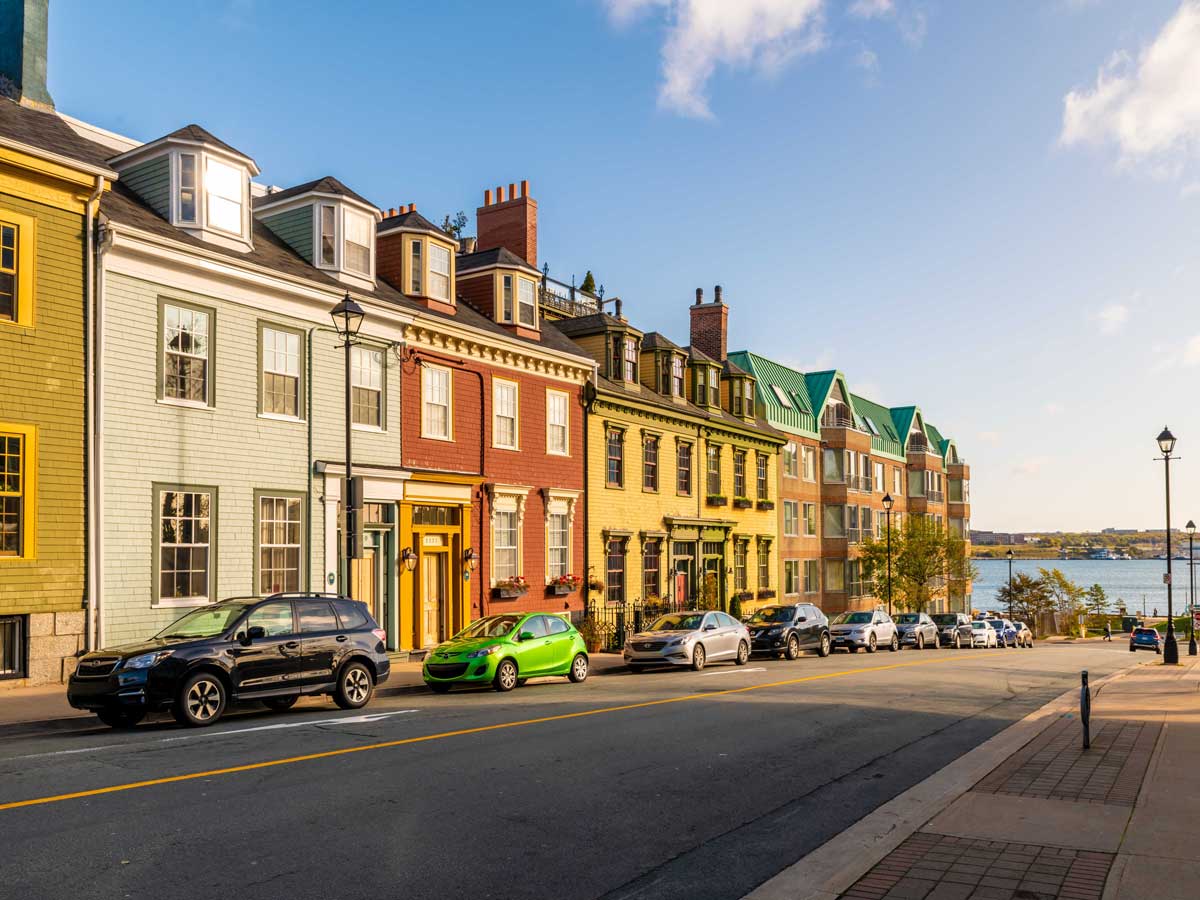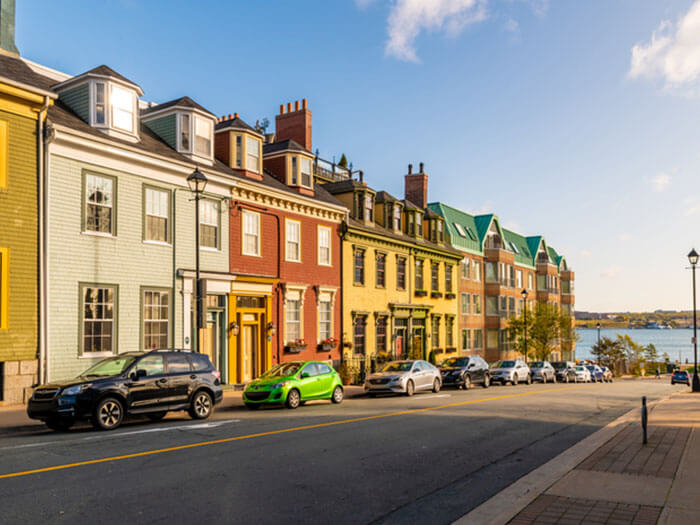
Canada’s housing market is breaking records at an alarming rate
 The average home price in the Halifax-Dartmouth area increased by 24 per cent between 2020 and 2021 (Getty Images)
The average home price in the Halifax-Dartmouth area increased by 24 per cent between 2020 and 2021 (Getty Images)
Who could’ve predicted it would take a global pandemic to push the Canadian housing market into overdrive? After setting sales records across the country in 2020, 2021 saw those records toppled once more and demand remains at a fever pitch, continuing to outstrip the supply of available properties and driving prices up. Throw in inflationary pressures and, according to the government’s December fiscal update, it will take “years” before the market can correct itself and return to normal, pre-pandemic conditions. With each passing month, Canada’s red-hot housing market continues to burn with no real signs of slowing down.
Over the first 10 months of 2021 alone, more than 580,000 homes were bought and sold, surpassing the amount from the entire previous year, when a record 552,423 homes changed hands. Overall, the national MLS Home Price Index finished the year up a record 25.3 per cent from 2020.
Home prices in Toronto reached a new record for the month of November—up 28.3 per cent from November 2020. As the number of new listings declined some—by double-digits in the condominium market—the average sale price hit an all-time high of $1.163 million, up 21.7 per cent from the previous year (the national average rose 19.6 per cent to $720,854). In Vancouver, meanwhile, sales rose 11.9 per cent while between September and October, sales jumped 8.6 per cent, marking the greatest single month-over-month increase since July 2020.
Market watchers agree that the market, fuelled by historically low interest rates and a lessening housing supply, shows no signs of significantly slowing down.
“I think nationally prices will continue to increase, at least in the short term,” says Martin Joyce, partner and national human and social services leader at KPMG. Although Joyce expects rising prices to include variability across markets in different provinces, the combination of low interest rates, strong inter-provincial migration and reduced supply on the market are likely to keep prices high for the foreseeable future.
At its January 2022 monetary policy review, the Bank of Canada maintained its overnight rate at 0.25 per cent—where it has been since the beginning of the pandemic—and signalled that it is expecting to hold the rate steady until the middle quarters of 2022, however a January report from J.P. Morgan predicted that conditions in the labour market and other factors may lead the Bank to raise rates ahead of schedule.
With an overnight rate hike those considering entering the housing market may act with more haste if they had planned to get in before mortgage rates creep up, says Benjamin Tal, deputy chief economist of CIBC Capital Markets.
“If you were planning to buy a house over the next year or so, maybe you want to accelerate and take advantage of extremely low interest rates now. That’s natural behaviour that we see every time interest rates start rising,” Tal says, “and then it slows down. If history is any guide, the next few months will be relatively elevated in terms of activity and then will start slowing down into the second half of 2022.”
Predicting the housing market over the course of the pandemic hasn’t been easy, as it hasn’t always behaved as people expected it to.
“Initially, we didn’t think that there would be the housing boom that we’ve seen, because you see people being laid off, companies getting shut down—you wouldn’t expect that people would be out buying houses,” says Julie Manna, a Calgary-based mortgage agent and CPA. “It did kind of catch us off guard in 2020 but, through 2021 we were expecting the ball to keep rolling. This past year was definitely an anomaly and a really busy year.”
For Manna, the housing boom hasn’t only brought more buyers into the market, but has also seen an increase in the number of people looking to capitalize on low interest rates and refinance homes they already own in order to take on work-from-home-friendly renovation projects. She adds that the past year has been unique for the frequency with which she is applying for rate holds (when a lender locks in a quoted interest rate) on mortgage pre-approvals.
“We’ve been underestimating the impact of millennials entering the home-buying age”
Manna says that, typically, she and her colleagues wouldn’t submit for rate holds on pre-approved mortgages. But, as the five-year fixed rates became more volatile near the close of 2021 (lowest advertised rates for five-year variable mortgages dropped to 0.85 per cent from 1.34 in a three-day span in November), she had been submitting almost every pre-approval for a rate hold, which usually run from 90 to 120 days for most lenders.
“We were doing a lot more rate holds,” she says, “and lots of panicked rate holds. Everybody was working until 10 o’clock at night.”
Tal attributes the strong pandemic housing market to the uneven economic impacts of the early shutdowns: lower-income Canadians, who tend to rent and are often younger, were the ones more likely to lose their jobs in the first extended lockdown, whereas higher-income workers were able to continue working virtually. Another factor contributing to the housing boom is demographics. According to a report from the Centre for Urban Research and Land Development, as of 2016 more than 700,000 millennials in Ontario’s Golden Horseshoe area alone were still living at home and likely to be aging into the market.
“I think we’ve been underestimating the impact of millennials entering home-buying age,” says Diana Petramala, senior economist at Ryerson University’s Centre for Urban Research and Land Development. “Millennials were holding less real estate but more cash in 2019 than generations before them. The ones that could afford to have clearly been saving for that down payment.”
Another factor is the presence of foreign buyers and large international real estate trusts in Canada’s housing market, for which Prime Minister Trudeau proposed a temporary ban in a December letter to Housing Minister Ahmad Hussen—in addition to other possible solutions like bringing an end to blind bidding.
As Hussen explained to reporters: “The point is to reduce the speculative demand in the market and help cool these astronomical increases in prices.”
 The average home price in Regina, Sask., jumped by 3.8 per cent in 2021 (Photograph by Dreamstime)
The average home price in Regina, Sask., jumped by 3.8 per cent in 2021 (Photograph by Dreamstime)
Although a hot housing market can be good for sellers, it’s less helpful for the wider national economy. First-time homebuyers looking to live in Canada’s biggest markets, like Vancouver or Toronto, may find themselves pushed out to smaller regional areas by record high prices; a decision that affects where they spend their money and which can affect employment when people return to the office.
Tal believes that a market slowdown, encouraged by slow and steady rate hikes from the Bank of Canada, would allow the market to adjust without derailing.
“The acceleration and activity that we saw in 2021 is not very healthy from a long-term perspective,” he says. “I don’t think the housing market should be a major contributor to economic growth.”
At its January monetary policy review, the Bank of Canada removed its “exceptional forward guidance.” Now that the economy has recovered from the initial shocks of COVID-19, the Bank’s main priority going forward is raising borrowing costs to get inflation under control. “Everybody should expect interest rates to be on a rising path,” Bank of Canada Governor Tiff Macklem told reporters. “A path is not one move. A path is a number of steps.” In December, the Bank’s 74-page Monetary Policy Framework Renewal report noted that “a prolonged period of low interest rates could contribute to a buildup of financial vulnerabilities.”
Jason Armstrong, a London, Ontario-based mortgage broker and CPA, has noticed an increase in the number of clients who require a co-signer to qualify for their desired mortgage and worries that people who have stretched themselves to enter the market while rates are low may be surprised at their lack of spending money once COVID-19 restrictions eventually ease up over time. [See Buying a home with a good friend? Read this first, if you’re planning on buying property with someone other than your partner or spouse.]
“Before, when you had a smaller house or you were renting, you had disposable income available to spend on travel and fun, frivolous things,” Armstrong says. “When that opens back up, it’s just a matter of time before they realize they’re worse off than they thought.”
The meteoric rise in prices has driven home ownership out of reach for many. The housing affordability crisis was a major issue in the fall election, with the Liberals pledging to invest nearly $20 billion in social infrastructure, prioritizing investment in affordable housing over the next 10 years. In 2022, a one per cent national tax on vacant homes owned by non-resident, non-Canadians is slated to take effect. Vancouver enacted its own vacant homes tax in 2017, which has since raised $86.6 million to support “a variety of affordable housing initiatives,” according to the city’s 2020 Empty Homes Tax Annual Report and has been accompanied by a 26 per cent drop in the number of vacant properties.
“You are 35-years-old, you are married, you have two kids and you are renting? Nothing is wrong with you.”
KPMG’s Joyce points to a recently adopted inclusionary zoning policy in Toronto that will require new residential developments to include a certain percentage of affordable housing units as “one of many solutions” to the issue.
“The further you go down this path of increasing house prices, the more radical the solutions will have to be,” he says. “Whether they get put forward or not, that’s a different story.”
Programs like the First-Time Home Buyer Incentive, which offers qualifying first-time buyers five to ten per cent of the cost of a home’s purchase price if the total amount borrowed is no more than four times the amount of a buyer’s qualifying income (or 4.5 times if the home being purchased is in Toronto, Vancouver or Victoria), seems out of step with the reality in local markets. Manna, for one, says she doesn’t see the program being used as much as it could be.
“The cost of housing has increased so much that the program just doesn’t make sense for a lot of people,” she says. More helpful, from her perspective, would be extending the amortization periods on CMHC-insured mortgages to 30 years, which would allow first-time buyers to enter the market a little more easily.
The 10-year, $72-billion National Housing Strategy is a good start at increasing affordability, but Ryerson’s Petramala says “it’s very small compared to the size of the problem” and could stand to be bolstered significantly.
Ultimately, the simplest solution could be a radical shift in mindset that would make owning a home feel like less of a necessity for more Canadians. An increased supply of purpose-built rental buildings and units—instead of a situation where the rental market and the condo market are one and the same—could help normalize renting as a viable long-term housing option.
“Purpose-built means that you basically introduce another element to the solution and you create a mentality in which you are 35 years old, you are married, you have two kids and you are renting? Nothing is wrong with you,” CIBC’s Tal says. “I think that’s a mentality that we have to develop.”
MORE FINANCE TRENDS
Read about the mortgage sharing trend for Canadians trying to get into the housing market. Plus, find out more about the inflation problem and how the microchip shortage is affecting the economy.